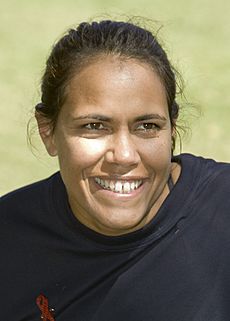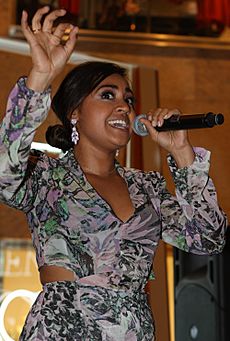Kuku Yalanji facts for kids


The Kuku Yalanji, also known as Gugu-Yalanji, Kuku Yalandji or Kokojelandji, are an Aboriginal Australian people originating from the rainforest regions of Far North Queensland.
Contents
Language
The traditional language of the people was Guugu Yalandji. It has been comprehensively studied, with a dictionary produced by the Hershbergers and a grammar by Elizabeth Patz.
Country
The Kuku Yalanji, according to Norman Tindale, held roughly 2,200 square miles (5,700 km2) of territory around the headwaters of the Palmer River. Their land ran east from Palmerville station to Mount Lukin, and stretched over the southern and western areas of the Dividing Range as far as the upper Mitchell River. their eastern limits lay around east to Byerstown, and they were present at Maytown.
Today
The Kuku Yalanji, believed to number some 3,000 people (2003), constitute one of the "Bama Rainforest Peoples". They are reputedly closely related to the Wulpura rain forest dwellers on the plateau in the modern day Mount Windsor National Park.
History of contact
Kuku Yalanji lands began to be occupied extensively by white colonisers in 1877, after the government opened up their area to selection, and as miners crowded into the area, where the Palmer River gold rush had been underway since news leaked out of a discovery of that mineral in June 1873.time. Within a year over 5,000 Europeans and 2,000 Chinese, mainly from Guangdong, crammed into the Palmer River site, until then the sole preserve of Kuku Yalanji people, to work its riches. Attempts made to uproot the people from their land were resisted, and a Lutheran mission opened up on the Bloomfield River in 1886 failed within 16 years of its establishment. century. Forced removals of some Kuku-Yalanji were undertaken again in the 1930s, with their relocation to missions at Daintree and Mossman. As late as 1957, a further attempt to relocate groups to a mission in Bloomfield took place. The gold rush lasted from 1873 to 1885, with the Palmer population of Chinese briefly skyrocketing to some 17,000 by 1877, until the opportunities for quick takings began to dwindle, with most Europeans leaving by 1880, and the Chinese numbers dropping drastically to 3,000. In response to this overwhelming invasion, the Kuku Yalanji set up a fierce resistance virtually tantamount to guerilla warfare.
The Kuku Yalanji eventually were reduced to living in shanty towns on the outskirts of the areas which the foreign populations developed, and developed skills for working in the new economy. Often, in trading their services with the Chinese, they were paid in opium, which could be imported legally until 1906.
From 1897 to the 1960s, the Kuku Yalanji like other Aboriginal peoples faced the Government's paternalistic legislation that allowed for Aboriginal people to be placed under "protection" in attempt to preserve their culture, placing them in Aboriginal reserves. The Kuku Yalanji began concentrating around the Mossman Reserve around the time of World War II and the people in the Daintree region were forced to the northern bank of the Daintree River. They were further subjected to more relocations by the government. Kuku Yalanji are now concentrated predominantly in Mossman and Wujal Wujal.
Traditional lifestyle
Survival was dependent on the exploitation of seasonal variation. It is believed that Kuku Yalanji lived in the rainforest region no later than 4,000 years ago. It is known that they had high population density, and lived in semi-permanent gunyahs. Their staples for obtaining carbohydrates were the toxic seeds of Cycas media, which were leached of their poisonous compounds before cooking; two species of yam, with the variety known as bitter yam particularly sought after, supplemented by bitter walnut, candlenuts and Kuranda quandong.
They classified the annual climatic cycle into five seasons.
Early reports often wrote that the Kuku Yalanji were devoted to cannibalism, targeting in particular Chinese immigrants, whom they called kubara or miran bilin (tight eyes). It is not infrequent to encounter early accounts of the eating of parts of the dead, which however was a restricted practice related to ritual mortuary customs. The vivid narrations of their killing their own women and children for eating to allay their hunger or of "feasting" on Chinese like "manna from heaven" in popular works like that of Hector Holthouse, are now considered wild exaggerations, since the actual evidence is skimpy. Christopher Anderson, who transcribed one account by an elderly fully initiated Kuku Yalanji man glosses the story by suggesting that:-
Apart from the probably rare actual incidents human flesh consumption, the strong European belief in Aboriginal cannibalism in this area arose and persists today, I would argue, as an ideological mechanism: it states and reinforces the belief that Aborigines were less human or at the very least were "uncivilized" (if they ate other humans). then justified their removal from the land and their extermination.
Native title
The Kuku-Yalanji people registered a Native Title Claim over parts of their traditional land in May 1995. The eastern Kuku Yalanji people were eventually recognised as the traditional owners of their land in the form of 15 Indigenous Land Use Agreements (ILUAs) in April 2007, covering more than 230,000 hectares (570,000 acres) between Mossman and Cooktown. In the agreements, signed on 19 October 2007, 64,000 hectares (160,000 acres) were designated as freehold land, partly for conservation and partly for residential or economic development use. The majority of the land would be managed by the Eastern Kuku Yalanji people and the Queensland Parks and Wildlife Service (QPWS).
In its determination, finalised on 9 December 2007, the Federal Court of Australia recognised that the Eastern Kuku Yalanji People have exclusive native title rights over 30,300 hectares (75,000 acres) of unallocated state land, which means that they "possess, occupy and use the area to the exclusion of all others" and have rights of succession and inheritance. In most of the area, which comprise 96,600 hectares (239,000 acres) of timber reserve, term leases and special leases, the Eastern Kuku Yalanji People have non-exclusive rights to hunting, camping, conducting ceremonies, burials, use of water and various other shared rights. The land is managed by an RNTBC, the Jabalbina Yalanji Aboriginal Corporation, which belongs to the Cape York Land Council.
Notable individuals
- Cathy Freeman, athlete
- Jessica Mauboy, Australian R&B and pop recording artist
- Pat O'Shane, teacher, barrister, and activist, Australia's first Aboriginal magistrate
- David Hudson, musician and cultural educator
- Tony Albert, artist, co-founder of artist collective proppaNOW
- Nathan Daly, former rugby league and rugby union player, Aboriginal health coordinator, is of Kuku Yalanji and Torres Strait Islander heritage.


